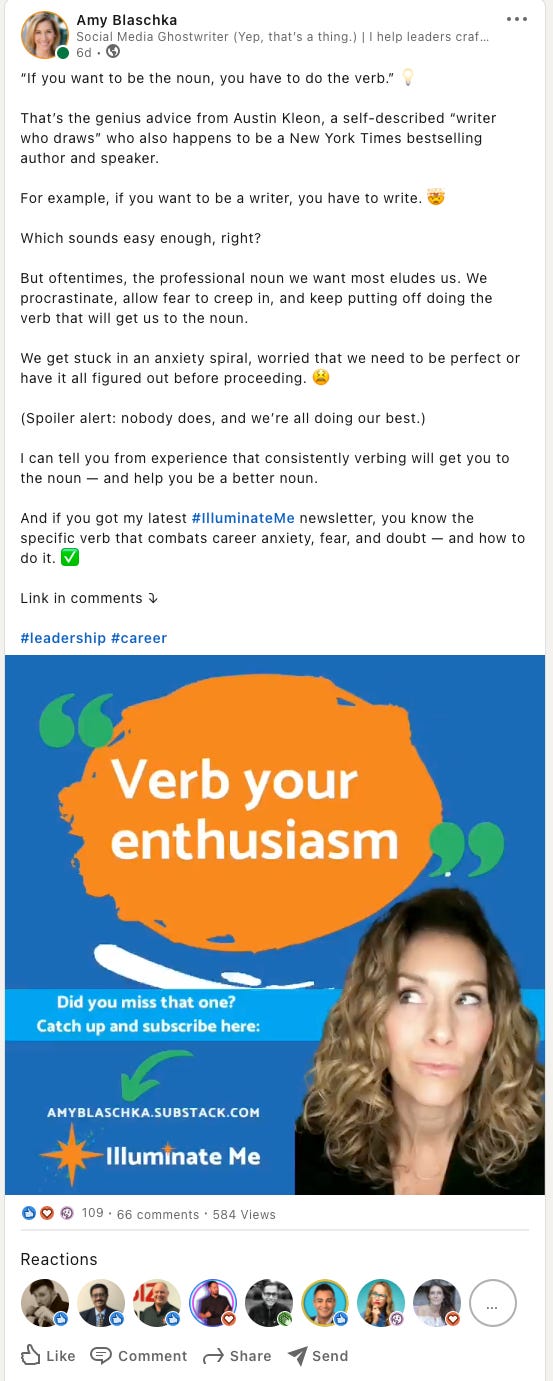My homemade latte hack: I use a whisk to froth heated almond milk.
(I rub both hands together to turn the whisk rapidly in opposite directions, almost like I’m trying to start a fire.)
It’s a little trick that helps me channel my inner MacGyver,* the title character of an ’80s TV show which taught us that there was tremendous value (sometimes lifesaving!) in repurposing things.
Among those things worthy of repurposing? Content.
While the need to repurpose your content may not qualify as a life or death situation (even if it feels like it sometimes), it is a smart option for many reasons:
Repeating your core themes and messages helps others attribute them back to you (read: personal branding and thought leadership boost)
People need to see something a few times to take it in
People learn in different ways; some prefer reading written formats (like you, my coruscant readers), some like listening to audio, others would rather peep an infographic, and some dig videos (with captions) so they can see, hear, and read info simultaneously
It gives you more quality content to regularly share
It saves you time (<— that’s a biggie)
Have I convinced you yet?
If I have, but you’re unsure where to start, don’t worry, boo; I got you. Here’s a breakdown of my best tips and exactly how I repurpose my content:
(Side note: Settle in with your favorite beverage of choice — this is a long one.)
Start with a piece of long-form content
When I say “long-form content,” I’m referring to something that has a bit of meat to it: an article, newsletter, podcast, video interview, etc. This is where you’ll pull out and repurpose bits into other forms of content.
For instance, every Saturday morning, I publish a long-form Forbes article that I share publicly on Mondays (and give first dibs to you fabulous readers on Sunday mornings). Here’s one from the May 16th Not feelin’ it issue of my newsletter:
Pro tip: “Evergreen” content — content not tied to a current event — has the longest legs and can be shared days, months, weeks, and even years later, provided it still offers value and reflects your current perspective. For this reason, most of my content is evergreen with a few specific, time-sensitive pieces.
Change the format and/or medium
This could be done using an entirely different medium, say by creating a pull quote infographic of a key takeaway from a podcast. Or, you can change things up in the same medium by presenting information in a new way, such as creating what’s known as a “roundup” article where you take the best of other articles and incorporate that information into a list within one piece, like this:
My absolute favorite tool for creating all my branded graphics is Canva. It’s easy to use and comes preloaded with tons of templates, graphics, fonts, and formats. And once you create something you love, you can create a copy of that graphic to tweak and something new (it’s own version of repurposing). I use the paid version, but the free version is a great place to start.
Pro tip: Keep your graphics consistent in look and feel by sticking to one color palette, format style, and set of fonts. The payoff for your consistency and discipline is excellent awareness of your personal brand and content before someone even reads it.
Following our earlier example, on a Tuesday a few months after publishing a Forbes article, I typically share an infographic and summary text that breaks down the main idea and takeaways of the article. However, for this article, I actually created a multi-page, downloadable PDF (click on the image to access the post and download) I shared across my social channels:
And about a month or so after that, I’ll share the information as an article on LinkedIn on a Friday. I posted this one last week:
Another example: I publish my newsletter on Sundays but share a graphic video teaser of it (created in Canva) the following Wednesday with a visual of the newsletter’s title and text about the key takeaway and value. I also provide links in the comments back to the specific issue of the newsletter, along with a link to subscribe. Here’s what the teaser looked like for last week’s issue:
Find a way to organize your content
It’s easy to be overwhelmed and disorganized without some structure. I highly recommend creating a content calendar to map out your content in advance and track its level of engagement (views/clicks, reactions, comments, shares, etc.) with your audience. Though you can get fancy, I use a Google Sheet for this that I update daily. I’m a visual person, so I like to color code mine by format and review it periodically to see what themes resonate most.
What you’ll find most helpful is being able to schedule out what you’ll post when. I do this in advance, highlighting in yellow the pieces I have to create.
Stuck on content ideas? Use your audience
If you’ve done what I’ve suggested above and created a content calendar to track your work, you should have a good idea of what resonates most with your audience (and what does not). Then, use those insights to double down on those topics and themes, exploring them in a new way.
You can also ask your audience about what they’d like to hear about from you using a LinkedIn or Twitter poll, or if you have a mailing list, by surveying them using a tool like SurveyMonkey.
Another idea is to do an AMA, or “ask me anything,” where you invite your followers to submit questions. You answer queries in whatever format you’d like, as Q&As are flexible. The first time I did this was through an #AskAmy video series. It was so well-received that I recently decided to do a second round. I share those videos on Thursdays; here’s one I answered last week:

Timesaver: Batch your content creation
Remember how I said I highlighted in yellow on my content calendar those pieces I needed to create? That’s to remind me what I need to do and group it for development.
I rarely create one piece of content in a sitting. Immediately after writing a Forbes article, for instance, I make the accompanying infographic and summary text. Also closely linked in theme to that Forbes article will be this newsletter, which I craft around the same time. And when I script, shoot, and edit my video content, I typically do two or more at a time.
For me, it’s easiest to block out dedicated time to batch content creation. This helps me focus on the task at hand and feel like I’m ahead of the game, rather than scrambling to get something done — never the ideal mindset for creation.
Something else that’s not ideal?
Blindly going through the motions of your professional world.
Because unfortunately, unconsciously repeating what you’ve already done often means you’re not intentionally growing or developing.
Fortunately, there's an antidote.
In my latest Forbes article, I share six ways cultivating self-awareness can help snap you out of a career rut:
Shine on,
Amy
P.S. When I’m not writing this newsletter or MacGyvering morning beverages, I’m a social media ghostwriter. (Yep, that’s a thing). I help founders, entrepreneurs, and CXOs craft their stories to communicate and connect better by magnifying their reach and impact. (Think personal branding and thought leadership.) Learn more here.
P.P.S. Now that we’re inbox-exclusive, you might want to follow my musings across the interwebs on Forbes, LinkedIn, Twitter, Instagram, and Clubhouse.
P.P.P.S. One more thing: You have great taste in newsletters—thanks for subscribing! And if you like it, I’m betting your friends might, too. The best way to grow a newsletter is through kind folks like you sharing with your favorite people. Or better yet, invite them to join our Illuminate Me tribe by subscribing!
*I’m also a fan of Bear Grylls, Babs (an adorable grandma I follow on Instagram who shares her wisdom), and anyone who teaches valuable life skills.













Amy! This was so good!
I love the concept that “verbing” will get us to the noun and help us be a better noun. It’s a simply out as we need it to be. 😉
We all need to just “verb” more often so we can become masters of our craft.
Looking forward to diving into more of your content!
Enjoy your day! :))